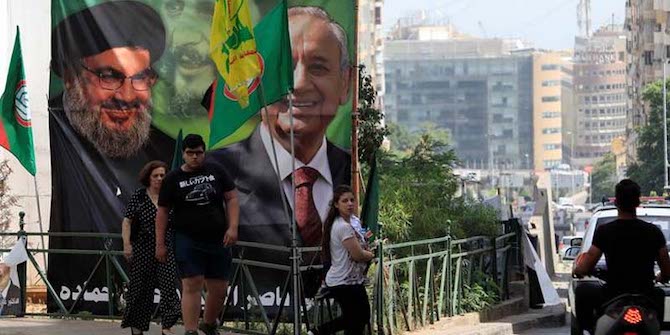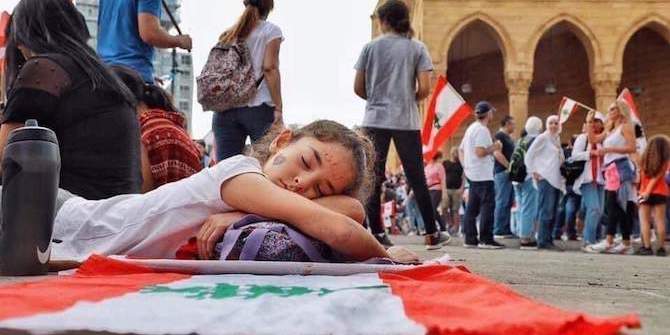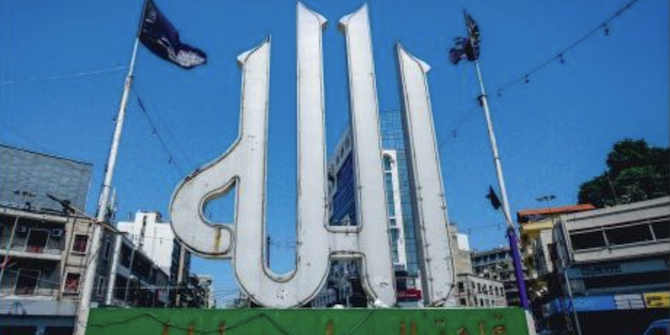by Wassim Mroue

With the outbreak of Lebanon’s anti-government protests in October, Hezbollah’s stance in support of the country’s political elite, including its allies in the Amal Movement, triggered a number of questions as pundits and journalists attempted to understand and explain the rationale behind such a position.
Contributing to this discussion, this article argues that we need to learn from the weight of history in order to understand the complexity of Hezbollah and Amal’s relationship, one of the pillars of Lebanon’s post-war political order.
Faced with soaring unemployment rates and mediocre public services, protesters from various regions, classes and sects took to the streets, chanted slogans and voiced corruption accusations against all political parties in power. In majority-Shi’a southern Lebanon, where Hezbollah and Amal enjoy wide support, accusations of corruption mainly targeted Amal. The latter has been represented in the Lebanese government since 1984 and its leader Nabih Berri has been speaker of Parliament since 1992.
While supporting people’s socioeconomic demands, Hezbollah leader Sayyed Hassan Nasrallah voiced his opposition to calls by some protesters for bringing down the government of Saad Hariri, the resignation of President Michel Aoun as well as Berri or for early legislative elections. In his first speech after the outbreak of protests, Nasrallah urged the government to prepare a series of economic reforms instead. In his second speech, he argued that some of the protests were being funded by foreign embassies, voicing fear of a plot to drag the country into a new civil war. At this point, Nasrallah urged Hezbollah supporters to withdraw from the protests.
Hariri did then resign in October and a new government was formed in January. Although the new Prime Minister Hassan Diab and most of his ministers are technocrats and not political party members, they received the backing of Hezbollah, Amal and their allies who gave them a vote of confidence in Parliament. In a February speech, Nasrallah expressed his party’s full support for the new government. But for many protesters, the new cabinet represented the interests of the same political establishment they rose up against in October. While anti-establishment demonstrations are no longer a daily occurrence, a new flare-up of protests is widely expected as the economic crisis deepens.
The dominant explanation put forward in Western media argues that Hezbollah is opposed to any genuine change of a corrupt political order given it is this system which provides legitimacy to the party’s arsenal and enables it to implement its agenda. Hezbollah, Amal and other allies have a majority in government and parliament. An alliance between Hezbollah and Aoun’s Free Patriotic Movement helped bring the latter to the presidency in 2016. The narrative continues that on a regional level, Iran, Hezbollah’s main backer, has no interest in seeing its influence in Lebanon decline.
While this argument does explain Hezbollah’s position to a certain extent, a deeper understanding requires one to move away from assuming that any single consideration drives the party’s stance on each Lebanese political group.
In fact, Hezbollah’s relationship with other Lebanese political parties has been conditioned by a set of distinct and complex local, regional and international factors and by the experience gained and the challenges faced since it emerged into public in 1985. All these factors shaped the group’s behaviour and made it what it is today. The relationship with Amal stands as a clear example.
Long before becoming part and parcel of the post-civil war political order, Hezbollah was already trying to cooperate with Amal, a pillar of this system.
In January 1989, under Syrian and Iranian sponsorship, Hezbollah and Amal signed an agreement to end months of fighting and reach a modus vivendi in south Lebanon. However, the peace deal failed to put an end to what would become a long chapter of Lebanon’s civil war.
Amal and Hezbollah, whose rivalry emerged in the midst of the civil war, had opposing views on the political orientation of Lebanon’s Shi’a community, its national and religious identity and their overarching vision for the future of Lebanon. Unlike Hezbollah, Amal does not believe in the doctrine of Velayat-e Faqih developed by Imam Rouhollah Khomeini, the founder of the Islamic Republic of Iran.
Tension between Amal and Hezbollah degenerated into unprecedented bloody confrontations in April 1988 when Amal managed to drive Hezbollah out of much of southern Lebanon except for a few pockets in the mountainous region of Iqlim At-Tuffah. The following month, Hezbollah hit back by wrestling control of most neighbourhoods in Beirut’s densely populated southern suburbs from Amal. The major theatre of combat then shifted to Iqlim At-Tuffah where both groups fought bitterly in January 1989 as Hezbollah tried hard to restore its positions in the south from where it could engage Israeli occupation troops. Guns fell silent in the aftermath of the Damascus Agreement reached at the end of the month, but battles escalated again after Lebanese MPs signed the Taif peace deal in October 1989 to end the civil war. Fighting broke out in December 1989 in Western Bekaa and spread again to Iqlim At-Tuffah where it continued on an intermittent scale throughout much of 1990.
The conflict finally came to an end under a second Damascus agreement brokered by Syria and Iran in November 1990. The deal reflected an understanding between Syria and Iran on Lebanon’s post-civil war order following years of tension between Damascus and Tehran.
An implicit division of labour crystalized shortly after the agreement whereby Hezbollah took charge of armed resistance against the Israeli occupation of the south while Amal occupied public sector posts and government positions allocated for the Shi’a community.
Today’s leaders of Amal and Hezbollah were all in senior positions during the bloody phase of their relationship and have seen its horrors at first hand. Deeply entrenched in the collective memory of Lebanon’s Shi’a community, the history of this conflict weighs heavily on Amal and Hezbollah and informs decisions and policies which guide their relationship.
My research has found that at least on the leadership level, Amal and Hezbollah have tried their best to forget their ‘war of brothers’ and their officials prefer not to even comment on this period in public. The three-year conflict divided families, involving tit-for-tat assassinations of leaders, the use of heavy weaponry, bombings, kidnappings and psychological warfare. The 14 June 1990 issue of the pan-Arab newspaper Al-Hayat put the number of deaths at 2,500.
This is why an in-depth examination of this history of the Amal-Hezbollah relationship is essential for a full understanding of the current status of relations between the two groups, close allies since 2005. Supporters of Amal and Hezbollah share cities and villages and hail from the same clans and families. Nasrallah himself was a senior Amal member until 1982 and his brother Hussein, aka Jihad al-Husseini, is a prominent Amal figure.
For Hezbollah, avoiding the reopening of old wounds – which took decades to heal – seems to be a crucial determinant of relations with Berri, a major figure in the political establishment. This trumps many other considerations.
An August 2018 speech by Nasrallah is indicative of this approach. While stressing his party’s seriousness in combatting corruption in the public sector, Nasrallah said that- ‘the Amal Movement and Hezbollah have made a historical decision to remain together … make sacrifices together and address problems together.’
The Hezbollah-Amal alliance is resilient despite feelings of uneasiness towards it by some segments of Lebanon’s Shi’a community and the Lebanese public in general. Shouldering its controversial military tasks in Syria, always preparing for a possible conflict with Israel and haunted by years of bloody internecine fighting, a breakup of relations with Amal is the last thing Hezbollah wants at this stage.






